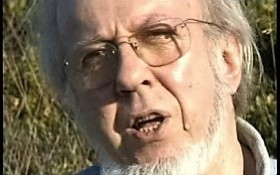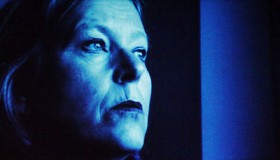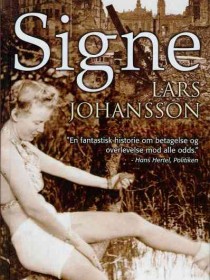En handling, en facade, et beboelsesrum, et ansigt – hver af disse er altid en opsummering. (Sune Jonsson: “Ni funderinger over 1/125-delen”, 1978)
Finn Larsen er den ene af de to fotografer (den anden er Lars Johansson) med udstillingen i Øksnehallen, København, ”Ung i Randers 1978-1979”, som Tue Steen Müller for nogle dage siden anmeldte begejstret her på Filmkommentaren og derfor må jeg lige repetere de tos arbejdsmæssige løbebaner, i dag altså Finn Larsens. Om hans fotografier skrev jeg engang i 1993 en introduktion i et tidsskrift, den tager jeg lige frem igen.
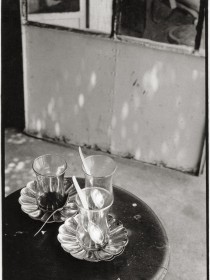
”Man kan godt begynde med de tre tyrkiske teglas. Fotografiet er titelvignet i Finn Larsens bog ”Billeder fra Tyrkiet” (1985). Jeg standser hver gang ved det billede. Sidder længe og funderer. Glassene er tømte, personerne har forladt dem, og de står tilbage på deres små tallerkener på cafébordet. De minder mig om en respektabel kultur, hvor man nøjes med lidt. De er så forbavsende små for en dansk tedrikker. Kan jeg forfriskes af så lidt, før jeg skal videre med dagens program, videre på rejsen? Ja, sådan er der i det land. Et glas te er nok. I den ting ligger landets sjæl som et konkret og materielt faktum. ”Tyrkiske teglas, Ankara, 1983” kan der stå på skiltet ved montren.

Billeder fra Tyrkiet (1985)
Finn Larsen er et rigtigt museumsmenneske. Allerede tidligt i 70’erne havde han opgaver på museet i Randers, han hjalp til ved udgravninger, indmålte tingene og noterede deres data. Han assisterede ved udstillingsarbejder, lærte at udvælge genstanden med fortællingen og skrive dens kendsgerninger på det lille skilt. Da han i 1977 begyndte sin fotografuddannelse, blev det helt selvfølgelig museet, som blev praktikstedet og museets fotograf Lars Johansson, som blev læremesteren. Finn Larsen blev museumsfotograf. Læretiden var et regulært samarbejde mellem de to, det førte blandt andet til den store fotodokumentariske registrering med udstillinger og en film om ungdomskultur i Randers 1978-1979…” I kataloget/avisen, som ledsager den aktuelle udstilling af dette materiale findes en fyldig og på mange måder forbavsende oversigt over hvad der videre skete:
FINN LARSEN FRA DENGANG TIL NU
Af Randi Jensen
Finn Larsens arbejde er over tid løbet sammen i tre tematiske spor, der alle består af en mangeårig, løbende indsamling af materiale til stadigt voksende arkiver, som er råstoffet for hans kunstneriske udstillings-virksomhed, udgivelser mv.: Tyrkietsporet startede 1983. Finn Larsen har rejst i/genbesøgt Tyrkiet hvert 5 år siden. Landskab-sporet har han arbejdet med siden 1988 i form af en række større og mindre fotografiske projekter om landskaber, der er formet af menneskelig/samfundsmæssig aktivitet, især i Danmark og Sverige. Grønlandssporet har han arbejdet med siden 1991, baseret på op mod 30 rejser.
Det var ret tilfældigt, at det var Tyrkiet og Grønland, der blev Finn Larsens faste udsigtspunkter uden for selve Danmark. Det var ikke helt så tilfældigt, at han flyttede til Malmø i 2004, men også det er et nyt sted at kigge ind og ud fra. Det handler for ham om at forankre perspektivet forskellige steder og derfra forsøge at se billeder, som man ikke har i hovedet i forvejen.
Fotografi er Finn Larsens indgang til verden, men han er blevet stadig mere interesseret i at arbejde med, hvordan kunst og fotografi spiller ind i verden, frem for bare at producere flere billeder. Det handler om at undersøge og fremlægge noget, der interesserer ham uden for sig selv.
TYRKIET
Projektet er påbegyndt i 1983 og Finn Larsen har genbesøgt Tyrkiet i 1988, 1993, 1998, 2003, 2008 og 2013. Det er et ”portræt over tid” af det Tyrkiet, der har tilknytning til Danmark via migration. Finn Larsen har gang på gang genbesøgt og meldt tilbage til de steder og mennesker, han mødte på sine tidligste rejser – mest konsekvent til landsbyen Himiroglu Koy, den nærmeste provinsby Corum og hovedstaden Ankara på indlandets højslette, men han har også flere gange besøgt storbyerne Istanbul og Izmir og den store landsby Kizilcasögut i Vesttyrkiet samt landsbyen Beskardes i det centrale Tyrkiet. Finn Larsens interesse i projektet har undervejs flyttet sig fra det primært kulturhistoriske til kunstneriske og samfundsmæssige perspektiver, der handler om at undersøge og anfægte vedtagne billeder og forestillinger.
Tyrkiet-sporet har undervejs resulteret i to bøger: ”Ingenmandsland eller Tyrkerne fra Randers” (Rosinante 1984) og ”Billeder fra Tyrkiet” (KLIM 1985) og otte udstillinger:
”Ingenmandsland eller Tyrkerne fra Randers”, vandreudstilling, biblioteker mv. i Danmark / ”Billeder fra Tyrkiet”, Galleri Image, Århus / ”Güzel [Smukt]”, Galleri Ægidius i Randers, 1988 samt museer med mere i Danmark, Sverige og Grønland / ”Kasaba [Lille by]”, blandt andre Kizilcasögut i Tyrkiet og Køge Museum, 1993 / ”Zaman ve Yer” [Tid og sted] på Nordjyllands Kunstmuseum, 2001 / ”Billedet af Tyrkiet?” på Det Kongelige Bibliotek i København. En dialog med Melchior Lorcks grafik fra 1500-tallets Istanbul, 2008 / ”Focus: Turkey” / Landskrona Museum, 2014 (gruppeudstilling) / ”Rejse i Tyrkiet”, Davids Samling i København, 2014-15.
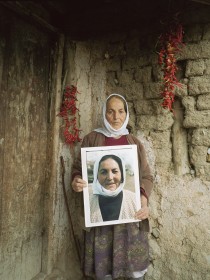
Kvinde i Himiroglu, Tyrkiet
GRØNLAND
Grønland er på nogle måder et fotografisk overeksponeret land – men det er ikke alt i Grønland, der er gennemfotograferet. Finn Larsen opdagede allerede ved sit første besøg i Sydgrønland i 1991, at der er betydeligt flere havedyrkere end fangere i Grønland – tydeligvis uden at hverken besøgende eller de fleste grønlændere har bemærket det. Det har været en væsentlig anledning til at Finn Larsen i stigende grad blev interesseret i at undersøge sammenhængen mellem fotografi, kommunikation og virkelighed og at udfordre vedtagne billeder og forestillinger gennem at fotografere det, som alle ser men ingen lægger mærke til – som f.eks. haver, træer, menneskeskabt landskab og lossepladser i Grønland. Og at fremlægge billederne i sammenhæng med viden om det grønlandske samfund baseret på andre kilder – grønlandske aviser, planer, rapporter, statistik og diskussioner med grønlændere og andre med interesse for landet. Den lille by Narsaq i Sydgrønland er det oprindelige udgangspunkt og det centrale omdrejningspunkt for hele Grønlands-sporet.
Grønlandsprojektet har resulteret i publikationerne ”NERI – Mad – Food. Mad i Grønland gennem 1000 år” (Hovedland, 2000), ”Tamaviaartumik. Haver i Grønland”(eget forlag, Malmö 2006) og ”MANS LAND” (avisformat Malmö, 2012) samt udstillingerne:
”Narsaq. Saligt er det folk, der kender frydesangen”, 1992. Museer i Grønland, Nationalmuseet m.fl. i Danmark samt museer i Sverige, Norge og Finland / ”Tamaviaartumik [Passion]. Haver i Grønland”, 2002. museer i Grønland, Museumscenter Aars med flere i Danmark og Malmö bibliotek / ”Eqqaavissuup Nunaa” [Lossepladsens land]. Med Nuka K. Godtfredsen og Lisbeth Valgreen, 2005. Narsaq Museum i Grønland /
”MANS LAND”, Dunkers Kulturhus i Helsingborg, Galleri Pi i København og museer i Grønland.
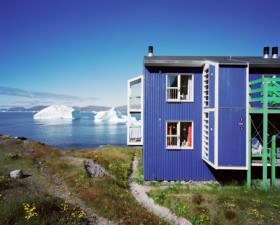
Mans Land
LOSSEPLADS

Finn Larsens foto: Fjorden ved Narsarsuaq, når han med sit kamera ser den ene vej, og når han vender sig og ser den anden vej.
The Dump – growing mountains of waste inGreenland, is part of the exhibition ”MANS LAND” 2012, Dunkers Kulturhus, Helsingborg, Galleri Pi, Copenhagen and museums in Greenland, now on Youtube:
https://www.youtube.com/watch?v=cta1-rrX6Xs&feature=youtu.be (The Dump, streaming, ENGLISH version)
There are 56,700 inhabitants in Greenland, in 18 cities and 50-60 settlements. There is practically no waste management. In the larger cities there are waste combustion systems, but they are undersized and malfunctioning.
Waste disposal management in Greenland is in worse state than it is in Denmark, even though Denmark is no role model. Numerous campaigns want to reduce Greenland to a victim of climate changes. But the majority of Greenlanders does not share this conviction.
The government of Greenland desires room for economic growth and as a result, they agitate the right to increase pollution. Oil drilling and extraction of gold and rare metals are under planning. The economic potential is immense. So are the possibilities of environmental disasters and the risk of expanding al-ready existing social gaps.
The problems Greenland is facing with waste disposal and societal dilemmas are the same, as those of other Nordic and European countries.The distinction is that the problems in Greenland are worse and more evident.
Greenland is no different from any other country. That’s the problem. (Finn Larsen, 2016)
Finn Larsen: The Dump, a journey from north to south of Greenland. Sweden, 2012 (web 2016) 26 min., YouTube. (LOSSEPLADS is written 21-01-2017 by Allan Berg Nielsen)
LANDSKAB
Dette spor i Finn Larsens arbejde består af en lang række fotografiske projekter, der afspejler hans interesse for, hvordan mennesker og deres virksomhed påvirker landskaber og landskabsopfattelse. De kunstnere og fotografier, der interesserer ham, indgår således i en global og historisk dialog om, hvordan verden ser ud og hvordan den formes i samspillet mellem natur og kultur. I projekterne har han arbejdet med f.eks. byer, landbrug, industri, råstofudvinding og ikke mindst trafik som forandrende kræfter i landskabet og han undersøger den måde vi opfatter landskabet på, alt efter hvilket forhold vi har til det. Også her forsøger han konsekvent at stille sig et andet sted og at se og fotografere andre billeder end dem, vi har i hovedet i forvejen.
LAND-sporet har resulteret i bøgerne ”BANE” (Forlaget B, 2001) og ”På den anden side” (Viborg 2005) samt ”LAND” (avisformat, København 2014). Desuden en lang række udstillinger, bl.a.:
”Saltholm”, Randers Kunstmuseum og Kastrupsgårdsamlingen, 1992 / ”Hække og Stativer. Bylandskaber i Randers”, Kulturhistorisk Museum og Randers Kunstmuseum samt Galleri Image i Aarhus, 1995 / ”Landskab”, Leoni Gallery, Viborg, 1999 / ”BANE”, Randers Kunstmuseum, Arkitekturskolens Udstillingsbygning i Århus, 2001 samt Kunstmuseet Arken, Ishøj, som del af udstillingen ”Nordiske Stemninger”, 2008 / ”PARK/AREAL”, Brænderigården i Viborg og Fotografisk Center i København, 2002 / ”TID og RUM”, Randers Kunstmuseum og forskellige offentlige pladser i Randers, 2003 / ”På den anden side”, udsmykning Viborg Handelsskole, 2005 / ”KALK” Form/Designcenter, Malmø, 2013 / ”LAND”, Museumsbygningen, København 2014 / ”GRÄNSEN” Malmøs kommunegrænse, serie på udstillingen, Tråkiga landskap, Malmø 2015.
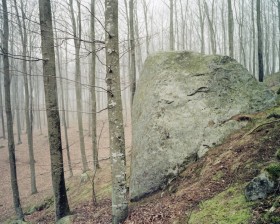
Skåne
SYNOPSIS
Finn Larsen (b. 1956) was interested as a child in archaeology and history. Aged 13, he became a volunteer helper at Randers Kulturhistoriske Museum. He graduated from there as photographer in 1980.
“What I have gained from my Museum studies is a broad, scientifically-oriented research as a background for and a continuous element in my photographic projects. I am thus notoriously curious on many levels in relation to what I am occupied with, for example regarding society, history, architecture, art, anthropology, geology and botany.”
Finn Larsen works with projects and primarily photographs landscapes that have been formed by human beings.
“The photographs and the art that interest me enter into a global and historical dialogue about how the world looks and how it can be understood. It is about seeing the world, society, the landscape as soberly as possible, without God, sentiments, nationalism, symbols and other abominations.”
Finn Larsen has published a number of books, and his BANE/TRACKS from 2001 was included in the Exhibition at the National Photography Museum, The Open Book 2006, as one of the twenty-eight most important Danish photography books. He has exhibited in numerous contexts, including: Arken Art Museum, Randers Art Museum and North Jutland’s Art Museum. His work is represented at the Museum of Art Photography, Odense and the National Photography Museum, Copenhagen.He is a member of the Society of Artists and the Association of Visual Artists in Denmark as well as the National Organisation of Artists in Sweden, where he lives and works. He has received travel- and work grants from the Danish National Arts Foundation, a travel grant from Fogtdal’s Photographer Prize and a work grant from the Swedish Author’s Fund. (Ole Christiansen, thephotographersprint.com)
LINKS OG LITT.:
https://www.kulturarv.dk/kid/VisWeilbach.do?kunstnerId=8840&wsektion=alle (Kunstindeks Danmark/Weilbach)
https://www.randerskunstmuseum.dk/media/21277/nr-3-2003 (Årets kunstner, Randers Kunstmuseum 2003)
Allan Berg Nielsen: “Sjælens materie”, Hrymfaxe, 23. 2. 1993.
Carsten Brandt: “Kendt fotograf i nyt format”, Foto & Video, nr. 4, 1993.
Finn Larsen, red.: “Ung i Randers 1978-1979”, avis / katalog, 96 sider til udstillingen, Museum Østjylland, Randers og Øksnehallen, København, 2016, info@finnlarsen.se
Foto: Finn Larsen på arbejde i 1978 fotograferet af Lars Johansson.





